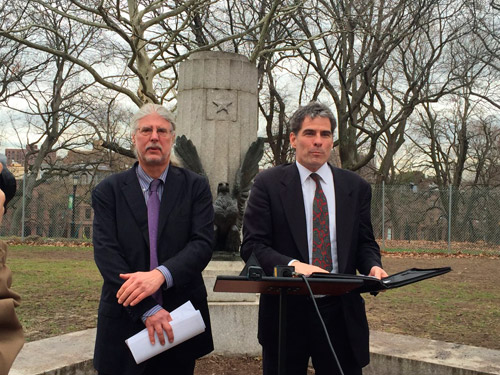The city’s controversial scheme to ax a small forest’s worth of trees in Fort Greene Park hit a snag after a state judge ordered the Parks Department to provide evidence that its plans will not impose a significant impact on the green space and surrounding neighborhood, setting back renovations to the area’s largest park.
State Supreme Court Judge Julio Rodriguez III sided with the environmental watchdogs at Friends of Fort Greene Park in ruling that the Parks Department failed to substantiate why its $10.5 million overhaul of the park — which entails chopping down a whopping 83 trees — does not constitute a significant alteration of the neighborhood’s namesake playground, according an attorney for the plaintiffs.
“This decision should awaken the department to reality,” said legal advisor Michael Gruen in a statement. “Environmental regulation is not enacted to be evaded as if it were merely an annoyance. It is designed to ensure serious and honest evaluation of environmental risks from the inception of governmental consideration of any project.”
The tree advocates argued that the city tried to bypass the State Environmental Quality Review Act by classifying the parks project as routine maintenance and accessibility upgrades, and the plant lovers are seeking the court’s intervention in forcing the city to conduct a lengthy environmental assessment.
The judgement will stall a planned upgrade of the 1867 park designed by famed Prospect Park landscape architects Frederick Law Olmsted and Calvert Vaux, and the city is still weighing whether to follow the order or contest it, a spokesman for the Law Department said.
“We disagree with this ruling. The city followed the law and the approvals needed for this type of project. An environmental review was not required,” said Nicholas Paolucci in a statement. “We are reviewing the city’s legal options to continue this important initiative.”
The agency plans to eliminate 83 trees, 52 to make way for a grand paved plaza at the Myrtle Avenue and St. Edwards Street corner of the park, and another 31 to accommodate a redesign of the area near Myrtle Avenue and Washington Park.
The upgrades includes an expansion of Fort Greene Park’s adult fitness area, the reconstruction of the basketball court, and tentative plans to tear up and replace the sidewalk at St. Edwards Street, which Rodriguez specifically noted in his decision, saying the Parks Department failed to explain why those aspects of the project constituted minor maintenance and repairs.
The Myrtle Avenue and St. Edwards Street corner would transform into a grand corner entrance that leads to the Prison Ship Martyrs Monument, which requires leveling some grassy mounds, creating a paved walkway to the memorial, and chopping down trees.
The head of Fort Greene Conservancy, a non-profit that works closely with the city on the park’s upkeep and supports the redesign, argued that chopping down the trees would allow for younger trees, shrubs, and ferns — collectively known as “understory growth” — to flourish, providing a better habitat for Brooklyn’s birds and bugs as well as help prevent erosion.
The years-in-the-works plans stalled when Friends of Fort Greene Park and Richard Lippes, a prominent lawyer for the environmentalist organization the Sierra Club sued the city in April, because they worried the concrete paving would create a hot zone that could harm the surrounding wildlife.
This marks the second time the Fort Greene group successfully took the city to court, after the advocates’s last lawsuit unveiled that the agency lied about the health of dozens of the trees to advance their plan.
Correction: A previous version of this story stated that Judge Rodriguez ordered the city to conduct an environmental assessment, when in fact the judge issued a more limited ruling requiring the city to clarify its decision to categorize certain aspects of the Fort Greene Park project as “minor maintenance and repairs.” It has been updated to accurately reflect the judge’s decision.
























